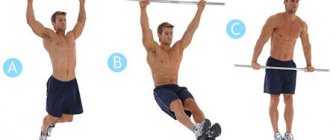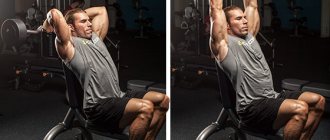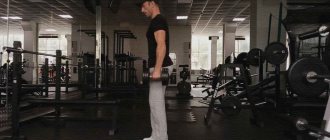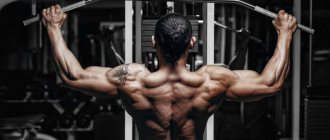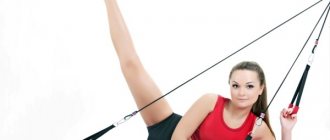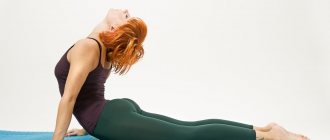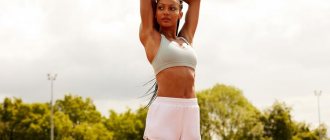Deadlift
Advantages:
This exercise is not just for the back. It affects a range of muscles in the back of the body, from the calves to the upper trapezius. Deadlifts are the best way to work your entire backside. When performing the exercise, it is extremely important to follow the correct technique. Once you master it, increase the weight. This will help you recruit more muscles, release muscle growth hormones, and gain mass.
There are many different deadlift training programs that can help you set your personal bests. Instructors like to suggest the deadlift for building strength and endurance because it works the muscles and is the best for strengthening bone tissue.
Deadlift
Perform classic deadlifts on back day. Other popular variations, such as the sumo deadlift, target other muscles.
When to do it:
If you're doing heavy deadlifts (maximum 6 reps), it's best to do them early in your workout, when you're still full of strength. If you intend to perform many repetitions, but with light weight, then you can do this exercise at any time.
Bent-over barbell row
Advantages:
This exercise ranks second among heavy lifting exercises. Research has shown that the bent-over row works both the upper and lower muscles equally, making it an excellent exercise for working the entire back. Like the deadlift, this exercise requires perfect technique, but it's worth it.
Bent-over barbell row with straight grip
When to do it:
Practice bent-over rows with heavy weights at the beginning of your workout, the number of repetitions per set is from 6 to 10 times. Doing this exercise in a Smith machine is also a good option. The machine keeps you in a vertical plane, but you need to make sure that your body is in the correct position relative to the bar. The bent over row puts much more stress on the lower back than other exercises. It’s worth taking pity on your lower back and doing this exercise at the beginning of your workout. If you're exhausted after deadlifting, it might be best to skip the bent-over row altogether.
Anatomy of the back muscles
Lower back (lower trapezius and erector spinae)
Function:
- The lower part of the trapezius acts on the scapula bone and is responsible for adducting the scapula towards the spine. While the erector spinae muscle straightens the spinal column and keeps the torso in an upright position.
Where is:
- at the bottom of the shoulder blades
How to pump up your lower back:
- hyperextension exercises
- forward bends with a barbell on the shoulders (“Good morning”)
Middle back (rhomboid dorsi)
Function:
- these muscles ensure the movement of the scapula towards the spine and upward.
Where is:
- attaches to the shoulder blades and spine in the middle part of the back, located under the trapezius muscle.
Exercises for the middle part of the back:
- Bent-over barbell row
- pull-down block to the belt while sitting
Latissimus dorsi muscles
Function:
- moving the arm down and back, relaxing the shoulder girdle, bending the torso to the side. These are the largest muscles of the back. They are responsible for the notorious V-shaped body, so pay special attention to them!
Where is:
- occupies the entire lower part of the back, with its upper part coming under the lower end of the trapezius muscle.
How to pump up the latissimus dorsi muscles:
- pull-ups
- seated wide-grip vertical pull-down
Trapezius (trapezius muscles)
Function:
- this is a group of muscles that brings the scapula closer to the spine, is responsible for the movement of the neck, shoulders and supports the head.
Where is:
- occupies a superficial position in the back of the neck and upper back.
Upper back exercises:
- shrugs with dumbbells
- standing vertical barbell row to the chest
Muscle atlas of the back
Wide grip pull-ups
Advantages:
Pull-ups are an excellent exercise for the back muscles. In wide-grip pull-ups, the main focus is on the upper latissimus muscles. A narrow grip increases the range of motion, but a wide grip places the body in a better starting position. The most difficult thing in this exercise is to maintain the desired pace with the number of repetitions from 8 to 12 times.
If you're doing pull-ups at the beginning of your workout, use a weight belt. If you find it difficult to perform this exercise, you can always replace it with a pull-up machine or use the help of a spotter. Also, a full-fledged replacement would be pulling the block down with a wide grip. If everything is in order with the shoulder joints, you can pull the block down behind your head.
It is extremely important to follow the execution technique: in the starting position, the shoulder blades should be brought together.
Wide grip pull-up on the horizontal bar
When to do it:
This exercise has a large range of motion, so a few repetitions will be enough to warm up the shoulder joints. Perform pull-ups at the beginning of your workout to focus on technique.
How to pump up your upper back at home
Wondering how to pump up your upper back? This article has selected an effective training program at home and in the gym. The set of exercises described below is aimed at working the upper back at home. Follow the correct technique, taking into account the recommendations and advice of a fitness trainer.
Read: How to warm up before training
A set of exercises for the upper back at home
| Exercises | Sets | Repetitions/Time |
| Reduction and separation of the shoulder blades | 2 | 20 |
| Bent-over dumbbell row | 2 | 15 |
| Exercise "Boat" for the back | 1 | 15-20 |
| Pushups | 2 | 15 |
Reduction and separation of the shoulder blades
Perform abduction and extension of the shoulder blades 2 times for 20 repetitions. The exercise will provide you with a feeling of lightness in your back.
Performance:
- Straighten up. Lower your chin. Fix your hands behind your head.
- Exhale. Pull your elbows back, squeezing your shoulder blades together. Stay in this position for a few seconds.
- Inhaling, return your hands to the starting position.
Reduction and separation of the shoulder blades
Bent-over dumbbell row
Repeat the exercise 15 times. Do two approaches.
Read: Effective exercises for the back
Performance:
- Stand in an inclined position. Place your feet wider than shoulder width. Take small dumbbells. Stop at the minimum numerical weight value. Place your hands with the apparatus along your body. Bend your knees slightly.
- Bend your elbows, thus lifting the dumbbells along a vertical path. The top point is the position of the hands near the belt.
Bent-over dumbbell row
"Boat"
Posture is formed, core muscles are strengthened. All back muscles are involved in the work. If you want to make it more difficult for yourself, pick up some weights.
Read: Training programs for pumping up the back
Performance:
- Lie on a flat surface with your stomach down. Extend your arms forward. Close your legs.
- Bend at the waist, lifting your limbs off the floor. Stay in the position for as long as possible.
- Perform 15-20 times.
Exercise "Boat" for the back
Push ups
Read: Exercises to pump up your back at home and in the gym
Performance:
- Lie on the floor with your stomach down. Place your palms under your shoulders. Press your toes into the floor.
- Raise and lower your torso using your elbow joints. Use only your palms and toes as support. If the exercise is difficult, focus on your knees.
Push ups
Watch your back: it should remain straight. Concentrate on muscle tension. Do 2 sets of 15 repetitions.
Standing T-bar row
Advantages:
For pumping up the back, the standing T-bar row is better than the lying barbell row on a bench, despite the fact that standing increases the load on the knees and hips. If you find it difficult to keep your back straight, do this exercise while lying down.
There is no need to squat too much; keep your knees slightly bent at all times. The position of the hands and the width of the grip can be varied. A wide grip works the latissimus muscles, while a neutral grip will allow you to concentrate on pumping the muscles of the middle part of the back: rhomboids, round and trapezius muscles. This exercise is one of the easiest on our list.
Standing T-bar row
When to do it:
It is recommended to perform in the first part of the workout. Focus on stretching and contracting your back muscles rather than lifting heavy weights. Increase the range of motion by slightly spreading your shoulder blades at the bottom. Make sure your back is straight at the beginning of each movement.
Back - exercises and training features[edit | edit code]
Yuzhakov Anton BEST EXERCISES FOR LATISM MUSCLES
The best exercises for the back
Back muscles: 1 - trapezius, 2 - latissimus, 3 - erector spinae Bodybuilding. Authors: R. T. Raevsky Bodybuilding. Authors: R. T. Raevsky
Training the back muscles contributes to the development of its V-shaped relief shape, which makes the waist and hips visually narrower, thereby making the figure look more aesthetically pleasing. The back muscles are large muscles, which makes them one of the main ones in bodybuilding, since without well-developed back muscles you will not have a harmonious figure, and your strength in squats or deadlifts will remain low.
Developed back muscles are also very important for the formation of correct and beautiful posture, since these muscles play a major role in stabilizing the spinal muscles.
It is due to the low tone of the trapezius muscles that the shoulders are retracted forward and a stoop develops. Read more:
- Posture correction – biomechanical basis of postural disorders.
- Stage 1 – general recommendations for changing lifestyle and movement patterns.
- Stage 2 – gymnastic exercises and stretching, necessary to eliminate muscle hypertonicity and mobilize the musculoskeletal system.
- How to correct posture (exercises) - building strength training aimed at strengthening target muscles.
Anatomy and functions[edit | edit code]
Read more:
Back muscles
The back muscles are located in several layers, so they are divided into deep and superficial, which, in turn, are also located in two layers. The appearance of the back is determined by three main muscles: the latissimus muscles, the trapezius muscles and the lower back muscles.
Wide grip lat pulldown
Advantages:
Compared to block rows with a narrow grip, a wide grip allows you to better work the upper latissimus muscles and adds variety to your workout. If you are performing wide-grip lat pull-downs, you should not use back machines on the same day, because they give the same load on the same muscles. If you change the grip width and move your hands to shoulder width, trying to press your elbows to your body as you move, the lower latissimus muscles will be more loaded.
Wide-grip horizontal block row to the waist
When to do it:
Like machine exercises, pull-downs are best done toward the end of your workout. Choose a weight so that you can do no more than 12 repetitions.
Content
- 1 Back - exercises and training features 1.1 Anatomy and functions
- 3.1 Basic exercises for the back
- 4.1 Exercises at home
- 5.1 Exercises at home
- 6.1 Exercises at home
Smith Machine Reverse Grip Row
Advantages:
The reverse grip engages the biceps and keeps the elbows close to the body, placing the load on the lower lats. Smith machine training allows you to concentrate on increasing your weight without worrying about maintaining your balance.
When performing the exercise, stand close to the barbell and tilt your body at an angle of about 45 degrees. When using heavy weights, you may feel stress on your knees and hips. Some experienced bodybuilders consider the Smith machine to be dangerous to the joints, but the stability of the body during movement and the ability to work with heavy weights make it suitable for beginner athletes.
When to do it:
It is enough to perform one exercise using a reverse grip per workout. Do Smith machine rows in the middle of your workout after doing overhand pull-ups. Use traction straps to take your mind off the grip and focus on working your back muscles.
Close-grip lat pull-down
Advantages:
Wide-grip lat pull-downs are similar to wide-grip pull-ups, so we'll use a narrow-grip version for this exercise. Research has shown that using a narrow neutral grip is the same as a regular grip: the same muscles will be used. A narrow grip gives a greater range of motion and increases the exposure time for the latissimus muscles.
Close-grip lat pulldown to chest
When to do it:
If you want to not just stretch your shoulders, but build muscle mass, then it is better to perform this exercise at the end of your workout, doing sets of 8-12 repetitions.
Make movements at a slow pace, contracting the muscles at the bottom and stretching them as you move up.
The best exercises to pump up your back muscles
Below are basic back exercises in the gym, which are aimed at developing and working out, as well as increasing strength. It is difficult to find isolating exercises for the back, because almost any movement involves several muscle groups at once.
It is worth noting that exercises for girls are fundamentally no different from those performed by men. Well, except that the working weights will be a little smaller.
Deadlift
The barbell deadlift takes an honorable first place in the top of the most effective exercises for pumping up the back.
This exercise is multi-joint, that is, when it is performed, several joints are involved at once, therefore, many muscle groups are pumped at the same time. When performing basic movements, not one, but several muscle groups are involved in the work. With deadlifts, you'll not only work your back, but also your core, legs, and glutes.
There are many variations of the deadlift: straight-legged deadlift, regular deadlift, sumo-style deadlift - although these varieties are very similar to each other, they are still aimed at working different parts of the back.
This exercise is best performed with a barbell, but a trap bar or even dumbbells will also work.
Pay special attention to your deadlift technique. Violation of the technique can threaten you with injury or strain in the lower back. Reps should be performed slowly, through a full range of motion. When lifting the barbell, keep your shins as close to the bar as possible.
Wide grip lat row
The lat pulldown is one of the most popular exercises among bodybuilders, and for good reason: it allows you to effectively broaden your back and improve definition.
Wide grip, narrow grip, reverse grip - there are many ways to work different parts of the back with lat pulldowns.
This exercise is used as an alternative or as a supplement to pull-ups and is aimed at pumping the latissimus muscles.
Pull-ups
Another excellent back width exercise is the pull-up. Grab the bar of the horizontal bar with both hands and lift your own body weight until your chin is above the bar. Simple, isn't it? However, it is pull-ups that can become a stumbling block for a novice athlete.
Having trouble doing pull-ups? You can ask a friend to help you or use special pull-up bands. Once you reach the required level of physical fitness, you will be able to perform this exercise without additional assistance.
As you get stronger, try increasing the number of repetitions or adding additional weight (or both).
Bent-over barbell row
Bent-over barbell rows are one of the most important exercises in a bodybuilder’s arsenal for pumping up the depth of the back. Thanks to it, your back will become much thicker, which will make you look really huge.
There are many variations of deadlifts that will allow you to build muscle in your back in no time. Here are just a few of them:
- One-arm dumbbell row
- Lower block thrust
- Pull-downs in the simulator with emphasis on the chest
- Bent-over dumbbell row
- T-bar row
The effectiveness of these exercises for increasing back mass has been tested by time. You can easily add each of them to your regular training program to remove fat and wrinkles from your back, making it muscular and strong. However, if you use all types of deadlifts and alternate them in your workouts, you can make your back thicker, stronger and more harmonious in the shortest possible time.
One-arm dumbbell row
Advantages:
This is a great unilateral exercise where each side works independently of the other, allowing for heavier weights to be used. Such exercises increase the range of motion and relieve stress on the lower back - you can lean on the bench with your free hand. A slight rotation of the body also engages the core muscles.
Bent-over dumbbell row with one hand
When to do it:
Provided that you keep your elbow pressed to your body, the main load will fall on your lower lats. Perform the exercise in the second part of the workout for 10-12 repetitions.
Pullover with dumbbell lying on an incline bench
Advantages:
Not everyone knows this, but pullovers are mostly a back exercise. The incline pullover uses the same muscles as the straight-arm lat pullover. This is a single-joint exercise that allows you to concentrate exclusively on working the latissimus muscles. Performing this exercise on an incline rather than a flat bench increases muscle load due to a greater range of motion. Lower the dumbbell behind your head, touching the floor at the bottom of the movement.
Incline Dumbbell Pullover
When to do it:
Single-joint exercises are almost always performed at the end of a workout on a specific body part. Don't slow down and do 12-15 repetitions per set.

